User Engagement Summary Report
Evaluate the health of your improvement culture by measuring people's engagement
The User Engagement Summary Report helps you to evaluate the health of your improvement culture by tracking the average number of Items submitted per person, the percentage of people who have logged in to KaiNexus, and the number of people who have used the system over a set period of time.
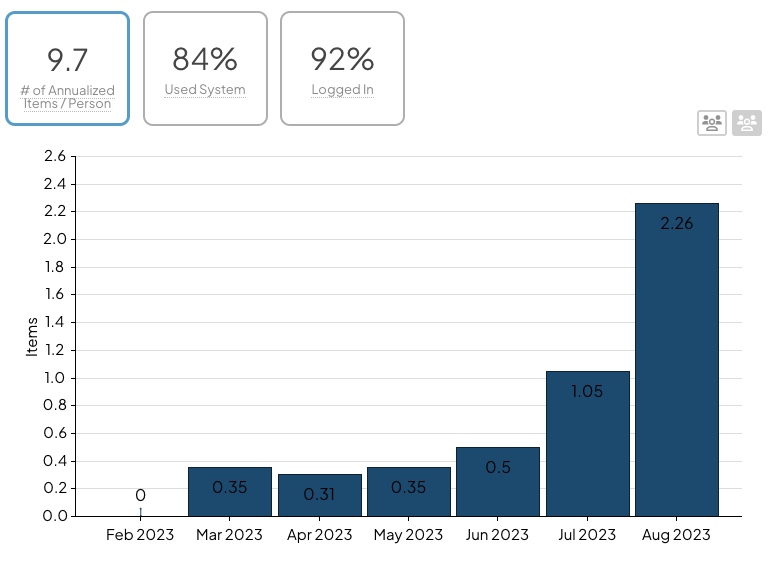
Example of a User Engagement Summary Report set to show the annualized Item submissions per person in each time interval.
Who can access this Report?
Anyone with the "View Report Data" permission will be able to see this Report.
This Report can be accessed under the Engagement section of the Reports page. It can also be added as a Card on a Board.
Working with the Report
- Understand the Report's views
- Use filters to control which data are referenced by the Report
- See a list of people referenced by the Report
- Share the Report
The views
This Report has three views. Click the name of the view you want to see to toggle between them.
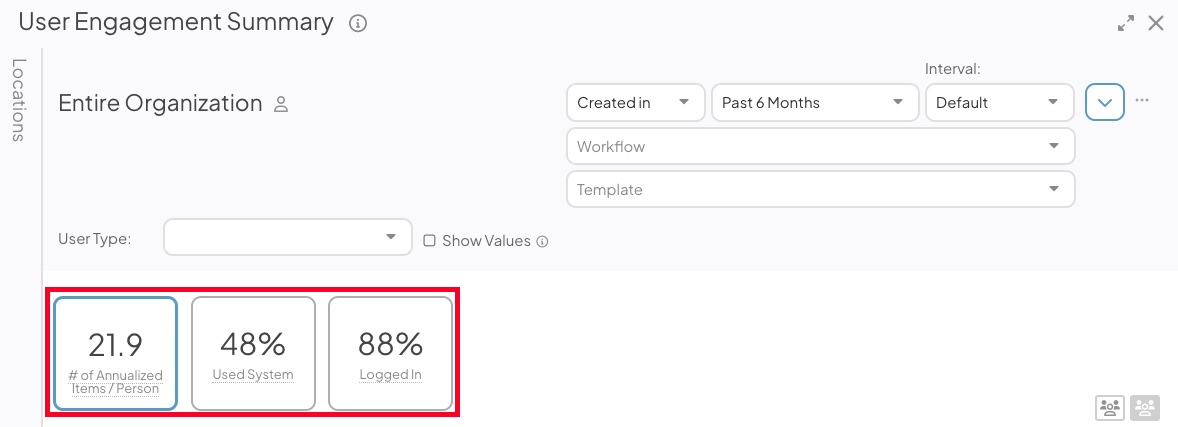
- # of Annualized Items/Person: This view shows you the annualized number of Item submissions divided by the current number of General users in your organization.
- Only Items meeting your filter criteria will be included in the calculation.
-
- Changing the reference date filter to Started in, Due in, or Completed in still shows annualized submissions. This filter only affects which Items are included in the calculation.
- Used System: This view shows you the percentage of General users who used KaiNexus in the set time frame and specified Locations. "Used the system" is defined as doing an activity in the system that generated a Timeline entry, such as entering a comment or resolving an Item.
- Note: The Template, Workflow, and reference date filters do not affect report data for this view.
- Logged In: This view shows you the percentage of General users who have logged into KaiNexus in the set time frame and specified Locations.
- Note: The Template, Workflow, and reference date filters do not affect report data for this view.
The filters
Any relevant filters in use on the main Reports screen will be automatically applied to this Report but can still be configured as needed.
- There are three date-based drop-downs. From left to right, there's the "reference date" drop-down, the "range" drop-down, and the "Interval" drop-down.
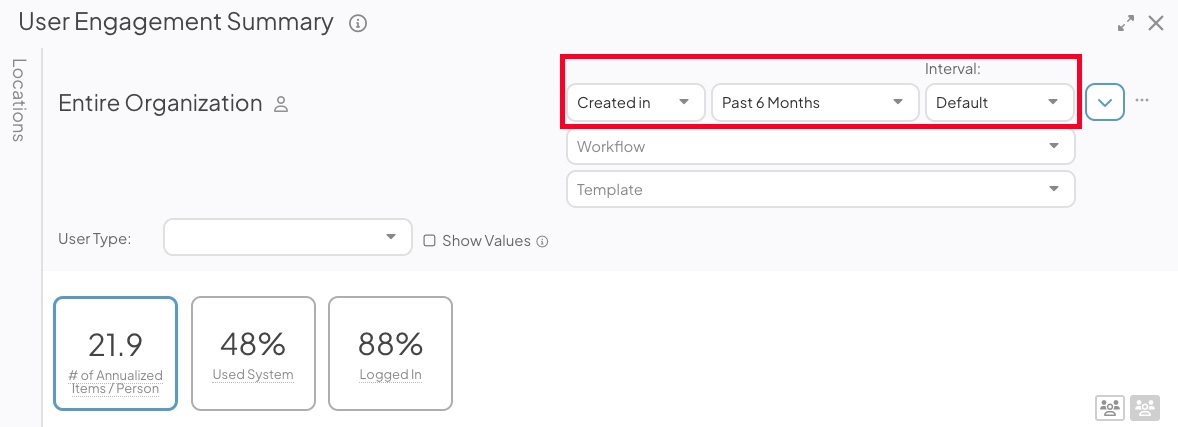
- Reference date: Expand the drop-down to choose which type of date should be referenced by the Report. For example, select "Created in" if you want the Report to reference only those Items that were created in the specified date range. This filter will only affect the Number of Annualized Items per Person.
- Range: Expand the drop-down to choose the range of dates that should be included in the Report.
- All Time removes any date range parameters.
- Custom allows you to enter any date range you want.
- Past shows you a rolling date range that counts back from the current calendar date.
- Current shows you data for the current week, month, quarter, or year.
- Last shows you data for the previous week, month, quarter, year, or multi-year period.
/Ofie/Ofie%20Profile%20Pic.png?width=50&height=50&name=Ofie%20Profile%20Pic.png) Pro Tip: The Last YTD option helps you set a date range matching the current year-to-date period but for the previous year instead. For example, if it is March 15th, 2024, and you select Last YTD, your Report will cover data from January 1st, 2023, to March 15th, 2023. This logic is also true for the Last MTD and QTD options.
Pro Tip: The Last YTD option helps you set a date range matching the current year-to-date period but for the previous year instead. For example, if it is March 15th, 2024, and you select Last YTD, your Report will cover data from January 1st, 2023, to March 15th, 2023. This logic is also true for the Last MTD and QTD options.
-
- Interval: Expand the drop-down to choose the interval, or "buckets," by which the Report should be organized.
- Workflow: Expand the drop-down to choose which workflows should be included in the Report. This filter will only affect the Number of Annualized Items per Person.
- Template: Expand the drop-down to choose which Templates should be included in the Report. This filter will only affect the Number of Annualized Items per Person.
- Select the person icon to open the People Filter.
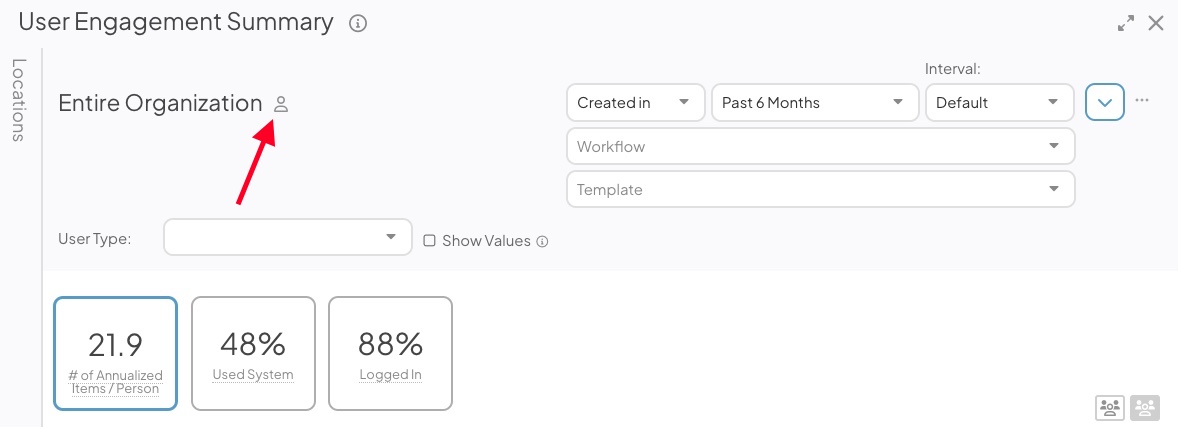
- Use the People Filter to control which Users are included in the Report's metrics.
- Select Save.
- Click the Locations panel on the left side of the Report to expand it.
- Filter the Report by Location, and only Items and people tied to the selected Locations will be included in the Report.
- User Type: Expand the drop-down to choose which types of users will be included in the Report.
- The Show Values checkbox: When enabled, the value of each data point will be displayed on the graph.
See a list of people referenced by the Report
For each of the three views, you can generate a list of people who do or do not meet the view's requirements. For example, if you're looking at the "Used System" view, you can see a list of everyone who has used the system or a list of everyone who has not used the system.
To generate one of these lists:
- Put the Report in the view in which you're interested.
- To see a list of everyone who meets the view's requirements, click the transparent users button. This is the button on the left.
To see a list of everyone who does not meet the view's requirements, click the gray users button. This is the button on the right.
/Reports/User%20Engagement%20Summary/User%20Engagement%20Summary%20-%20People%20Toggles.jpeg?width=670&height=240&name=User%20Engagement%20Summary%20-%20People%20Toggles.jpeg)
Share the Report
To share the Report, select the ellipsis icon. In the resulting drop-down menu, you can export the Report as a PDF or copy it to a Board.
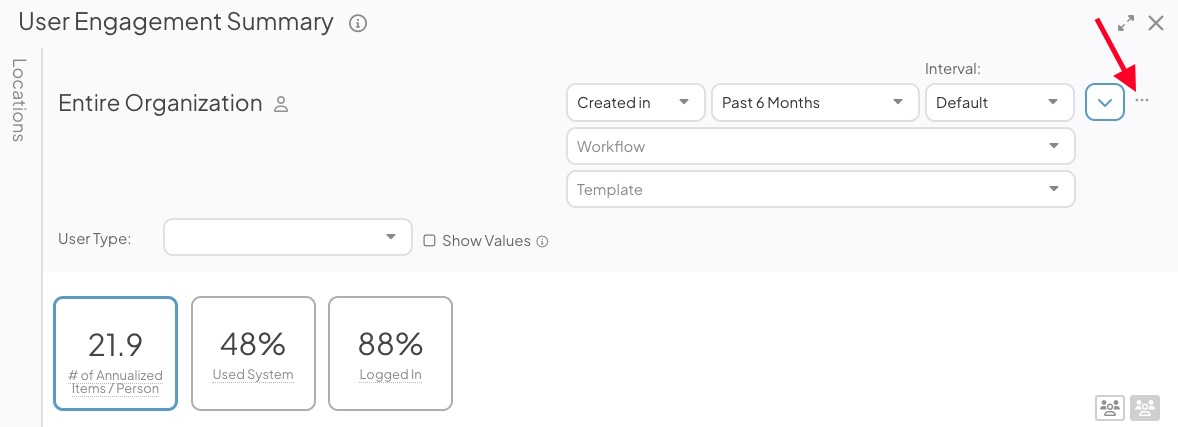
- Select Print/Save PDF to export the Report as a PDF. The "Print" window will open.
- Page Size: Expand the drop-down to choose your preferred page size.
- Scale: Expand the drop-down to choose the scale percentage. This allows you to fit more content on a single page. For example, selecting 50% doubles the amount of content you can fit on one page. Make sure to select "Fit to page" in your browser's print settings.
- Click either Portrait or Landscape to choose the PDF's orientation.
- Click Print.
/Ofie/Ofie%20Profile%20Pic.png?width=50&height=50&name=Ofie%20Profile%20Pic.png) The Location of the Report will appear on the exported PDF beneath the Report title.
The Location of the Report will appear on the exported PDF beneath the Report title.
- Select Copy to Board to add the Report as a Card on a Board.
- In the resulting window, select a Board. All Boards that you have permission to edit will appear as options.
- Select Copy to add the Report to your selected Board. All filters and columns included on the Report will be carried over to the Card.
- The Report Card will appear at the Board's top left corner.